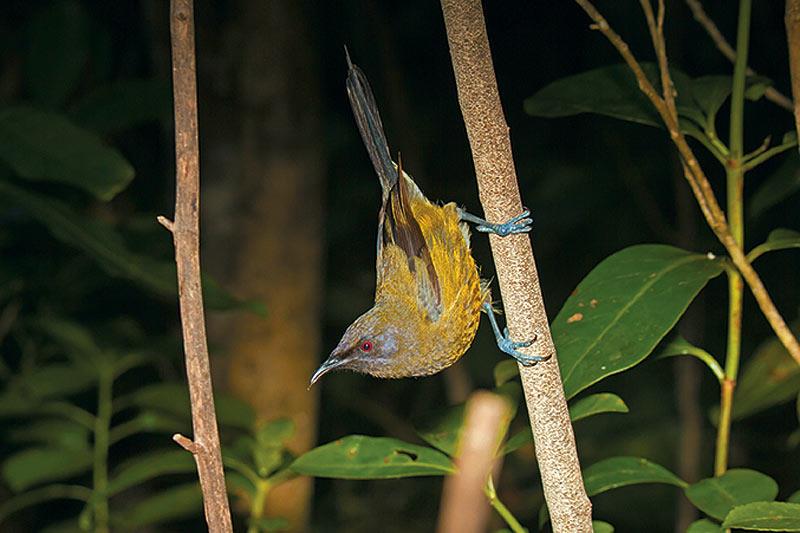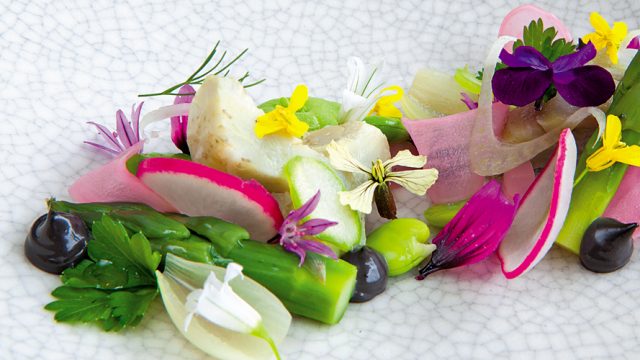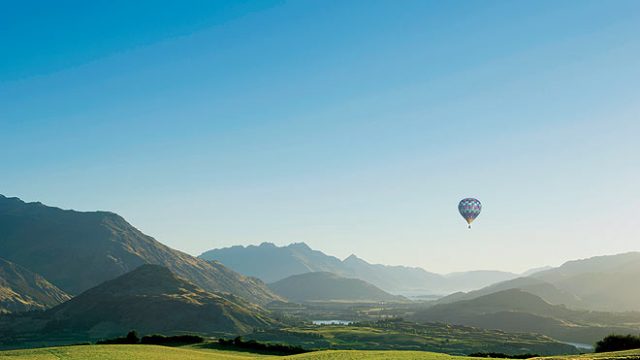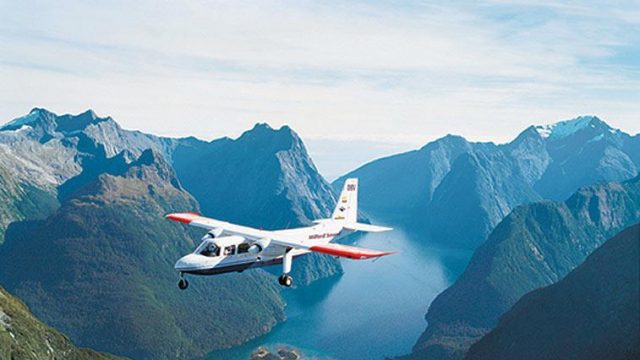There was something unnatural about this: to be standing within two feet of a paradise shelduck. We
This was not the lone experience of such close proximity to wildlife during our trip to New Zealand. We had already travelled for a few weeks and had visited some nature reserves in North Island. Our first stop was at a small island near Auckland with an evocative name, Tiritiri Matangi, which translates from Maori as ‘tossed by the wind’. This island has seen a very successful regeneration programme undertaken by the Department of Conservation with the support of a huge number of volunteers from Auckland. Together they planted thousands of native trees that had been lost over centuries as the ownership of the island changed hands, ever since the first Maoris landed there.
The first trees and bushes that were planted included the famous Pohutukawa and the Manuka, vegetation that was well suited to coastal areas as they could withstand strong salt-laden winds. Pohutukawa (Metrosideros excelsa) is the Maori name of the tree that is sometimes referred to as the Christmas tree because it comes into full bloom in December, setting the coast ablaze with its bright red flowers. Incidentally, New Zealanders refer to plant and animal species by their Maori names; common English names are rarely known or rarely used.
Restoring native vegetation was not the only challenge New Zealand has had to deal with. Mammalian invasive predators like the possum, stoat, goat, deer and the Polynesian rat devastated the native fauna and flora as their numbers grew phenomenally. The rat was introduced by the Maoris when they came to these islands about eight hundred years ago. It was an important source of food and protein for them. Most other predators, however, were introduced by the Europeans for varied reasons: the possum to establish a fur trade, the stoat to keep rabbit numbers in check and the deer for hunting. The New Zealand Government’s Department of Conservation has used traps, aerial spraying of bait drops and fencing of areas in a planned manner and have successfully made over ninety islands pest-free so far. Tiritiri Matangi is one of them.
As we started our guided walk through one of the paths through the forest on Tiritiri, I was annoyed by our guide talking loudly. I could hear the chirping of many birds around us, but our guide seemed oblivious, as she continued to share the island’s early history with us in decibel levels that seemed entirely inappropriate for a nature reserve. It felt impolite to interrupt her so I hinted hard by scanning the trees and turning in the direction of the bird calls. That proved too subtle; and we continued in this manner till we reached a ‘feeder station’, a place where birds could have a drink of liquid nectar supplied by the Department.
Suddenly they were all around us. The Tui (parson bird, Prosthemadera novaeseelandiae), the Korimako (bell bird, Anthornis melanura), the Hihi (stitchbird, Notiomystis cincta) and the Toutouwai (North Island robin, Petroica longipes) — all fabulously close! The robin almost hopped up to my shoes scanning the ground for insects. Initially I attributed this fearless behaviour of the birds to the feeder but, later in the day, I walked within three feet of a Kereru (New Zealand pigeon, Hemiphaga novaeseelandiae) perched on a branch. All it did was stare fixedly at me. Still later in our travels there was the Kaka (a parrot species, Nestor septentrionalis) that did not budge even though a few of us kept creeping closer to photograph it.
Some species had obviously lost their fear since New Zealand was for millions of years free of mammalian predators till humans beings arrived and were predators themselves or introduced some. A study done by Otago University, however, attributes this trusting behaviour to the birds growing in environments that have been made ‘safe’. They found that robins that grow up in islands that have been made rat-free have no fear of rats, whereas robins in islands that still have rats exhibit fear.
‘New Zealand 100% Pure’ is the slogan that advertises New Zealand for travellers. At the end of our three-week stint in the country I was left confused by the claim. We had travelled from Auckland to the northern part of South Island and also spent three days in Great Barrier, an island to the east of New Zealand. Since my friend and I were both nature enthusiasts, we had planned our itinerary to include visits to some national parks and sanctuaries, including walks through the country’s forests and coastal regions.
I was wildly excited by the opportunity to travel in an island country and spot wildlife that I had never dreamed of seeing. I had read a little about island biogeography and learned about high levels of species endemism and species gigantism that some islands display. I wondered if I would be fortunate enough to see New Zealand’s giant Weta, or the Tuatara, a reptile that is the only surviving member of an order that existed two hundred million years ago when the dinosaurs were around. They are now found only in New Zealand.
I was certainly not left disappointed. Even though the only Weta that I saw was a dead specimen in a glass case, and the Tuatara was a live one in an enclosure at an aquarium, I was treated to abundant, joyful wildlife sightings. A glimpse of a penguin left me excited, coming within three feet of a seal was fun and spotting sperm whales on a whaling trip was, well, indescribable.
Why then did this country produce a mix of reactions in me? Why was I a bit confused? Did it not seem cent per cent ‘pure’? Sure, the island had lost some unique species to predation, like the moa, a flightless bird, of which one species was supposedly almost twelve feet tall, and the Haast’s eagle, which was supposedly the largest eagle that ever existed.
As we bussed it through North Island from Auckland to Wellington, visiting some fascinating tourist destinations en route (particularly Rotorua, but more about that visit later), what struck us was the almost unchanging landscape, beautiful as it was. Cruising along in comfortable buses on smooth roads, I wondered if what I was missing was the diversity that surrounds you when travelling back home — of landscapes, people, lifestyles. Was I, in fact, missing the chaos of my country? There was not only a near-perfect feel to everything around us, but a kind of homogeneity in the gentle rolling green hills, wineries, farms and fields.
We took some fabulous walks through forests in the Abel Tasman National Park, Karori Sanctuary in Zealandia in Wellington, Glenfern Sanctuary in Great Barrier Island and Waitakere near Auckland. But the forests seemed tame in more respects than one. Through all our forest treks, there were well laid-out tracks with appropriate signage that showed you the right path to take as well as informed you about how long it would take to your next destination. If the paths were a little steep, there were wooden steps that helped you negotiate the terrain. There were toilet facilities along the way. But the tameness of the experience was perhaps best captured in the words of one of our guides. As our vehicle headed in the direction of the Abel Tasman National Park, he chirped enthusiastically, “…and you would be sure glad that we have none of those nasty creepy crawlies in our forests!” He later helpfully clarified that the “nasty creatures” were snakes, scorpions and deadly spiders. While the walks were indeed fabulous in terms of the natural beauty that surrounded us and the picturesque vistas that greeted the eye, I did miss the excitement and anticipation that I had come to associate with walks through India’s forests, where one often does not know what small or big, harmless or harmful, creature one is going to chance upon!
If so much of New Zealand was of a certain sameness, then visiting Rotorua broke all stereotypes. It literally took my breath away. The city lies at a distance of about 230 kilometres south-east of Auckland. We arrived late in the evening, just in time to find accommodation at the splendidly run Youth Hostel. The next morning a faint putrid smell filled the air. A brief walk around the city provided the explanation: the area was dotted with small hot springs. Unbelievably, these existed in public parks, in the backyard of houses, at the side of a church and so on, hence earning Rotorua the nickname of ‘Sulphur City’.
We opted for a trip to the nearby Te Whakareware thermal village operated by a group of Maoris to witness the famed Pohutu geyser, which erupts to a height of twenty metres or so once every hour. We walked around the geothermal landscape amidst mud pools and geysers, while we waited for the hourly spectacle to enfold. And while it did, we were close enough to feel the intense heat and steam as well as have our camera lenses fog up. While this trip provided me my first ever glimpse of a magnificent geyser, it didn’t in any way prepare me for the wonders of the Waimangu Volcanic Valley which we visited the next day.
On June 10, 1886 a volcano erupted in this region. A protected scenic reserve, the Waimangu Volcanic Valley offers views of different forms of geothermal activity from crater-filled pools, hot springs, a stunning emerald pool, a bubbling lake appropriately called ‘Frying Pan Lake’ and eruption deposits. All these fascinating views are possible as you undertake a pamphlet-guided trek down a gentle incline. From certain points along the route the area appears almost ethereal: hot mineral-rich springs rising from the ground, the air filled with steam and gases and the smell of sulphuric acid, mountain sides clothed with a wide diversity of thermally adapted plants.
It was during this stunning walk through a living, bubbling landscape that the glib ad copy ‘New Zealand 100% Pure’ broke my reverie. I looked around at the enveloping wonders and found myself muttering, “Yes. Hmm, maybe, yes…”
Getting there
There are no direct flights from India to New Zealand. But Southeast Asian carriers such as Malaysian, Thai and Singapore connect Delhi/Mumbai with Auckland with one stop. Return economy fares start from Rs 50,000 (Delhi) and Rs 60,000 (Mumbai).
Where to stay
There are many options for various budgets: backpackers, motels, hotels, luxury spa retreats. Our preferred budget accommodation was the Youth Hostel Association (YHA) which offers comfortable and spotlessly clean rooms (shared or private), equipped kitchens, paid internet access and TV lounges. We used YHA accommodation at Rotorua, Nelson and Kaikoura. Tariffs were in the range of NZ$60-110 (NZ$1 = Rs 45); members get discounts. See yha.co.nz.
At Great Barrier Island we stayed at Great Barrier Lodge (NZ$90; greatbarrierlodge.co.nz). In Wellington (where the YHA was full up), we stayed at Nomads Capital Backpackers (NZ$95 for en suite doubles/from NZ$29 for dorm beds; nomadsworld.com).
What to see & do
Tiritiri matangi Daily ferries from Auckland are available for day-trips, else book ahead to stay at the bunkhouse. Tip: it’s good to book ahead anyway as the ferry service is limited. Guided walks are organised by Supporters of Tiritiri (doc.govt.nz)
Rotorua Experience geothermal earth forces at Waimangu Volcanic Valley and Maori cultural performances at Tepuia.
Nelson This is a lovely town to walk or cycle around. Visit Abel Tasman National Park for coastal walks (options range from a three-hour walk to 3 to 5 days).
Kaikoura Whale-watching tours, coastal walks, swimming with the dolphins, eating crayfish.
Great Barrier Island Fly from Auckland (30mins) or take a ferry. If your budget permits, fly at least one way for spectacular views. Lots of walking tracks, some with hot springs where you can swim. You can also go diving, snorkelling and swimming. Do also visit Glenfern Sanctuary.
birding in New Zealand
New Zealand
travelogue





